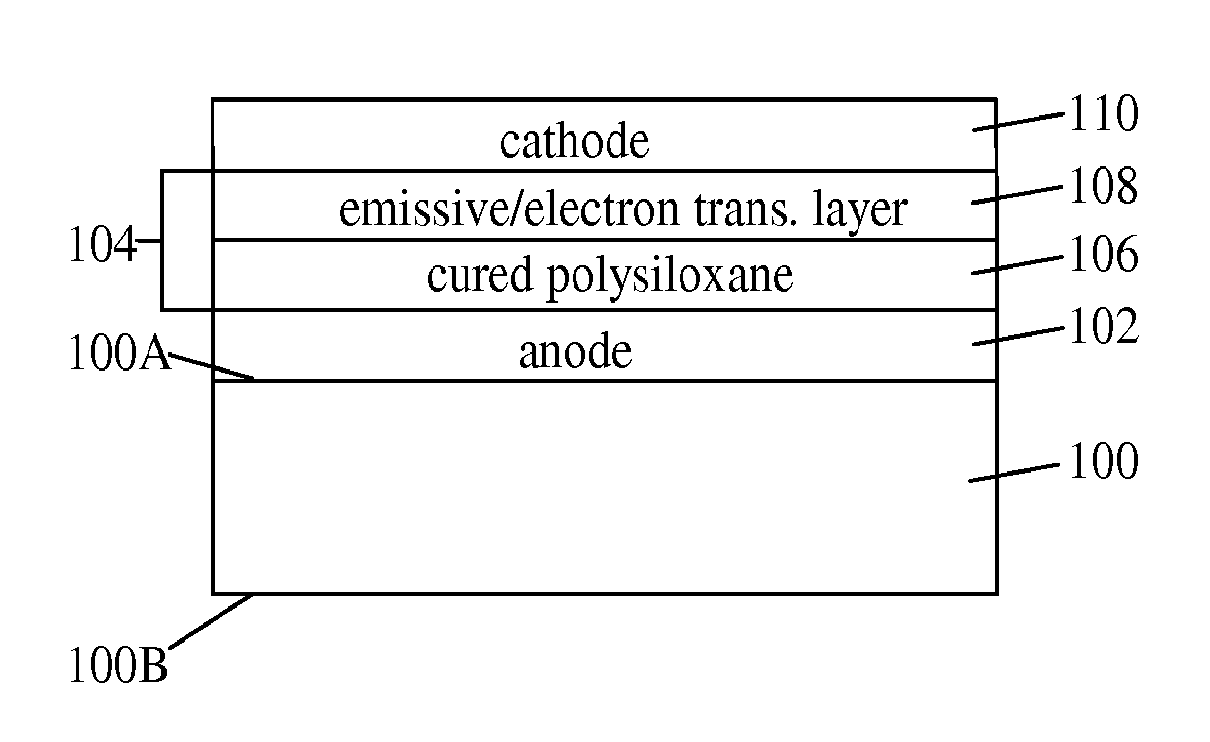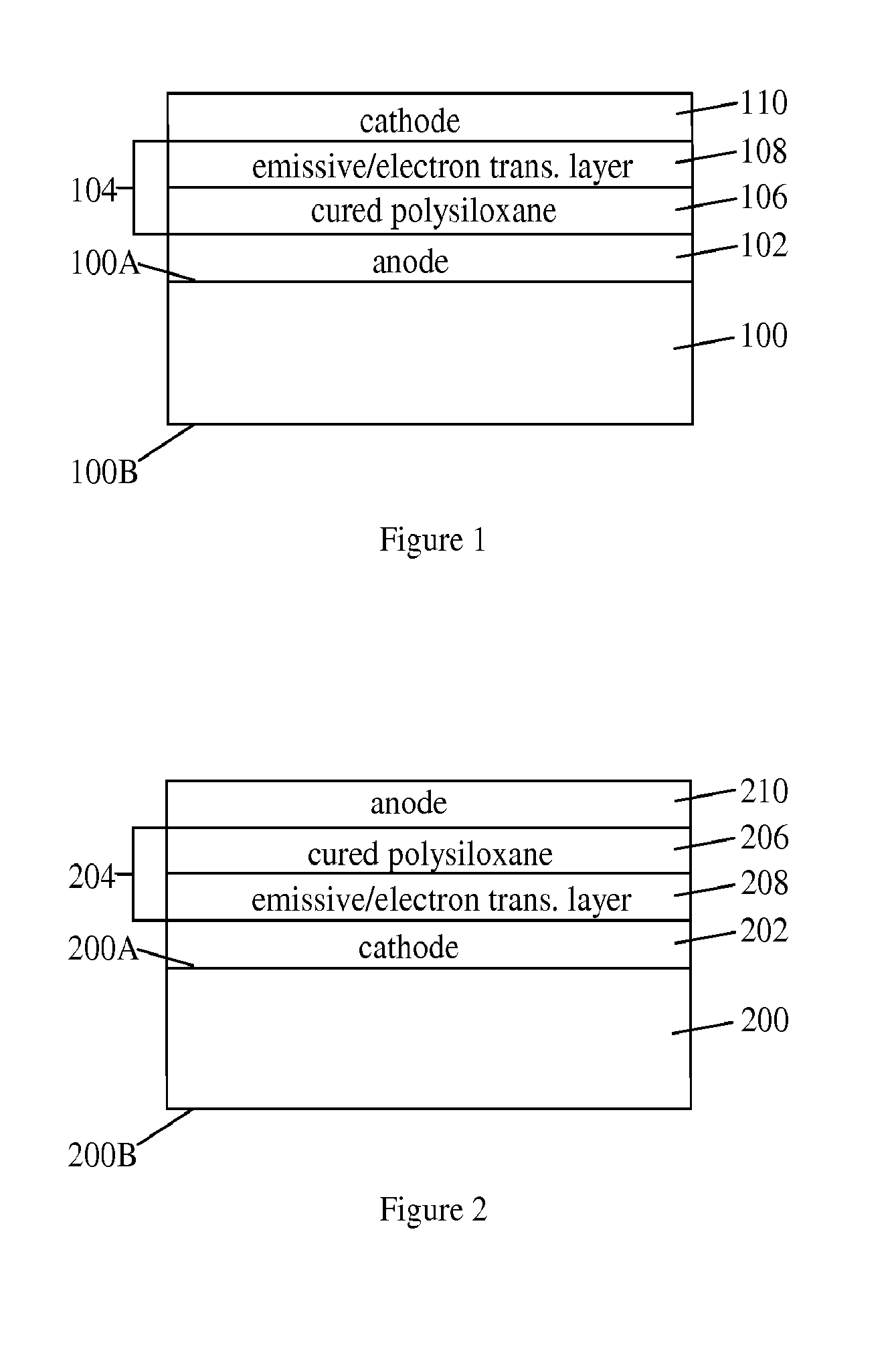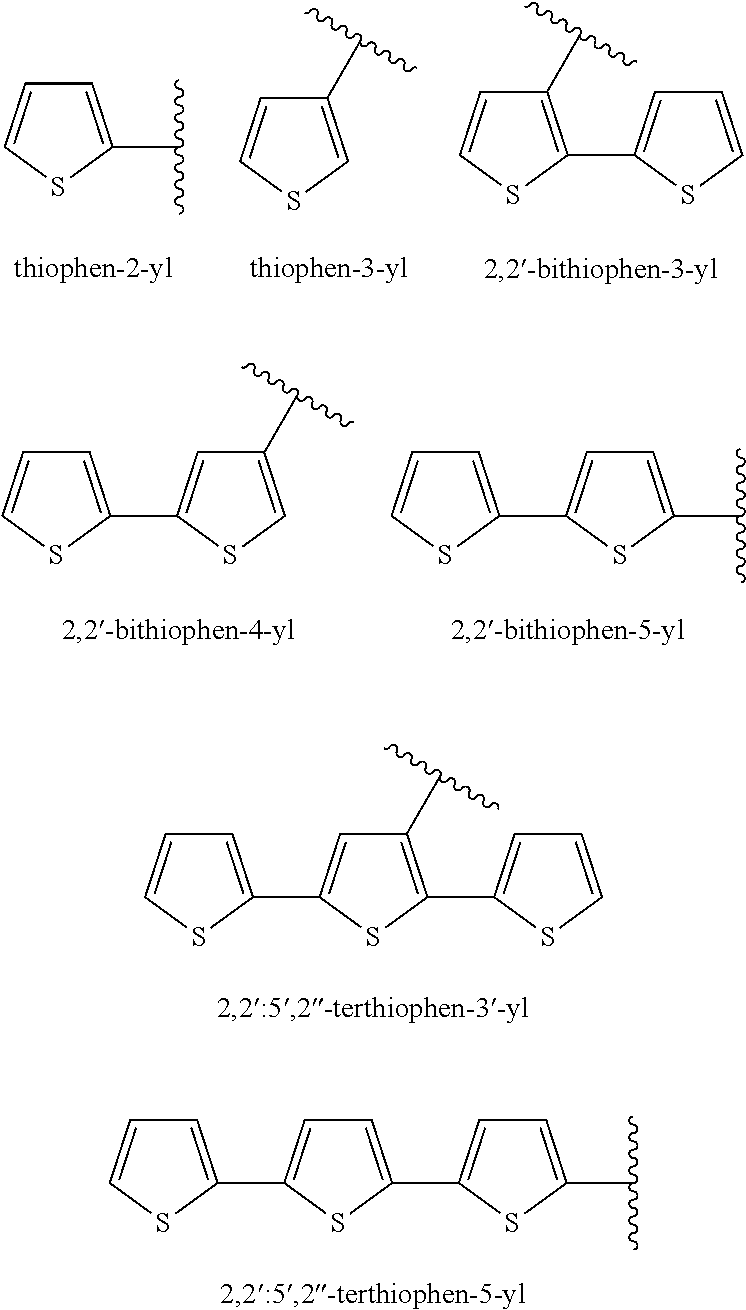Silicone Composition and Organic Light-Emitting Diode
a light-emitting diode and composition technology, applied in the field of composition, can solve the problems of high acidity, low transparency, high resistance of pdot, etc., and achieve the effects of low turn-on voltage, high brightness, and high transparency
- Summary
- Abstract
- Description
- Claims
- Application Information
AI Technical Summary
Benefits of technology
Problems solved by technology
Method used
Image
Examples
example 1
[0115]2-Allylthiophene (25 g), 13 g of anhydrous toluene (13 g), and 250 mg of Platinum Catalyst were combined under nitrogen in a three-neck flask equipped with a reflux condenser and a dropping funnel. Then, 30 g of trichlorosilane was added drop-wise to the mixture. Upon completion of the addition, the mixture was heated to 60° C. and maintained at that temperature for 2 h. Then, the mixture was distilled at 150° C. and 0.02 ton to give 2-(3-trichlorosilylpropyl)thiophene as a colorless liquid: 1H NMR (CDCl3) δ 7.16 (dd, 1H, J=5.1, 0.9 Hz); 6.95 (dd, 1H, J=4.8, 3.3 Hz); 6.83 (m, 1H); 2.96 (t, 2H, J=7.2 Hz); 1.98 (m, 2H); 1.46 (m, 2H).
[0116]2-(3-Trichlorosilylpropyl)thiophene (5.0 g) and 50 g of methyl isobutyl ketone were combined in a flask. Then, 400 mg of silicon tetrachloride and 430 mg of 1,8-bis(trichlorosilyl)octane were added to the solution. The resulting mixture was cooled at −78° C. for 1 h. Next, 10 g of water was added to the mixture during a period of 1 h. When the ...
example 2
[0117]The hydrosilylation reaction of Example 1 was repeated using 18.7 g of 5-allyl-2,2′-bithiophene in place of 2-allylthiophene, 10 g of anhydrous toluene, 20 g of trichlorosilane, and 150 mg of Platinum Catalyst. 5-(3-Trichlorosilylpropyl)-2,2′-bithiophene was obtained as a colorless liquid: 1H NMR (CDCl3) δ 7.20 (dd, 1H, J=5.1, 1.2 Hz); 7.14 (dd, 1H, J=3.6, 0.9 Hz); 7.02 (m, 2H); 6.74 (d, 1H, J=3.6 Hz); 2.93 (t, 2H, J=7.2 Hz); 1.99 (m, 2H); 1.49 (m, 2H).
[0118]The hydrolysis reaction of Example 1 was repeated using 5-(3-trichlorosilylpropyl)-2,2′-bithiophene in place of 2-(3-trichlorosilylpropyl)thiophene.
example 3
[0119]The hydrosilylation reaction of Example 1 was repeated using 4.5 g of 2-allyl-5-methylthiophene in place of 2-allylthiophene, 2.5 g of anhydrous toluene, 5.0 g of trichlorosilane, and 50 mg of Platinum Catalyst. 2-(3-Trichlorosilylpropyl)-5-methylthiophene was obtained as a colorless liquid: 1H NMR (CDCl3) δ 6.60 (m, 2H); 2.88 (t, 2H, J=7.2 Hz); 2.47 (s, 3H); 1.95 (m, 2H); 1.47 (m, 2H).
[0120]The hydrolysis reaction of Example 1 was repeated using 2-(3-trichlorosilylpropyl)-5-methylthiophene in place of 2-(3-trichlorosilylpropyl)thiophene.
PUM
| Property | Measurement | Unit |
|---|---|---|
| temperature | aaaaa | aaaaa |
| temperature | aaaaa | aaaaa |
| temperature | aaaaa | aaaaa |
Abstract
Description
Claims
Application Information
 Login to View More
Login to View More - R&D
- Intellectual Property
- Life Sciences
- Materials
- Tech Scout
- Unparalleled Data Quality
- Higher Quality Content
- 60% Fewer Hallucinations
Browse by: Latest US Patents, China's latest patents, Technical Efficacy Thesaurus, Application Domain, Technology Topic, Popular Technical Reports.
© 2025 PatSnap. All rights reserved.Legal|Privacy policy|Modern Slavery Act Transparency Statement|Sitemap|About US| Contact US: help@patsnap.com



